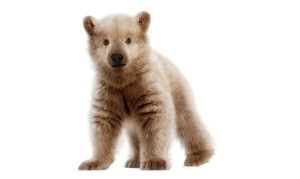
Climate change has already caused the interbreeding of some animals—most notably a hybrid polar bear and grizzly bear cub known as a grolar bear or a pizzly.
But new research suggests the interbreeding risk may not be as dire as previously believed.
Looking across North and South America to tally the potential number of such pairings, a study finds that only about 6 percent of closely related species whose ranges do not currently overlap are likely to come into contact by the end of this century.
ARCTIC MELTING POT
“Climate change is causing species’ ranges to shift, and that could bring a lot of closely related species into contact,” says Meade Krosby, a research scientist in the University of Washington’s Climate Impacts Group.
“People have been concerned that climate change would be bringing all these species into contact, and that this could unleash a wave of interbreeding. What we found is, not so much.”
A 2010 editorial in the journal Nature suggested that northern species may begin to interbreed and create a so-called “Arctic melting pot,” and even prompted one artist’s rendition of what those new offspring would look like.
The idea also worries land managers looking at how to prepare for climate change. At a workshop, land managers told Krosby they worked with very closely related species separated by small distances. What if managers linked the two areas with a wildlife corridor, and as the climate changed the species started to mix?
BIG PICTURE? NOT A HUGE PROBLEM
The new study, published in Nature Climate Change, is an attempt to see how much that should be a concern. Researchers looked at 9,577 pairs of closely related species of birds, mammals, and amphibians in North and South America. For the 4,796 pairs whose ranges currently do not overlap, computer models show that only 6.4 percent of them will come into contact due to climate change by the year 2100.
The most overlap among species occurred in the tropics, and among birds, likely because more species live in the tropics and birds cover wider ranges, Krosby says.
While the study suggests that climate change is unlikely to result in widespread interbreeding, wildlife biologists still need to consider their particular region and animals of interest to best protect specific populations.
“Managers still need to look case-by-case at species at a local scale, but at a global scale, the big picture is that it’s probably not going to be a huge problem,” Krosby says.
The study likely overestimates how many species could be at risk of interbreeding because it assumes that all species will be able to access new habitats that become available due to climate change. In fact, natural barriers prevent animals from reaching all potential new habitats, and humans have created new barriers such as highways, farms, and cities that can block migrations to more hospitable places.
“The number one strategy for helping biodiversity respond to climate change is to increase connectivity, to link up habitats that have been fragmented by human activity, so species can move, and track climate as it shifts to stay comfortable,” Krosby says.
“If people are worried that wildlife corridors and other ways to increase connectivity could bring these species into contact, we’re saying: That’s probably not going to happen, and allowing species to move is far more important.”
Other researchers from University of Washington and from the National Audubon Society, California State University Monterey Bay, and Georgia Institute of Technology contributed to the study. The Wilburforce Foundation, the Doris Duke Foundation, and the David and Lucile Packard Foundation funded the work.
Source: University of Washington and Futurity.org








